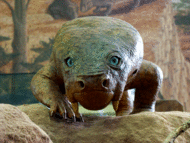Internal anatomy of therapsid skulls (Forerunners of Mammals)
The oldest mammals are known from the Late Triassic and evolved from a group of more primitive land-living vertebrates, the therapsids. Because therapsids were already particularly mammal-like, they are essential for the understanding of early mammalian evolution. Although numerous well preserved therapsid fossils from South Africa, Russia, China and South America exist, poorly is known about the internal anatomy of their skulls. We therefore plan to examine fossil skulls of these animals with neutron tomography and modern techniques of 3D modeling. Among others these examinations provide new insights into respiration, the functions of the brain and nervous system, senses (olfaction and hearing) and the feeding apparatus. A main goal of our project is to explore unknown sinus systems in the skull of anomodonts, which is a group of herbivorous therapsids. Air-filled sinuses in the skull are also known from extant mammals and humans, but are almost completely unknown from therapsids. PhD student: Michael Laaß
PIs: apl Prof. Dr. Eberhard “Dino” Frey SMNK, Prof. Dr. Wolfgang Stinnesbeck Excellency University Heidelberg






